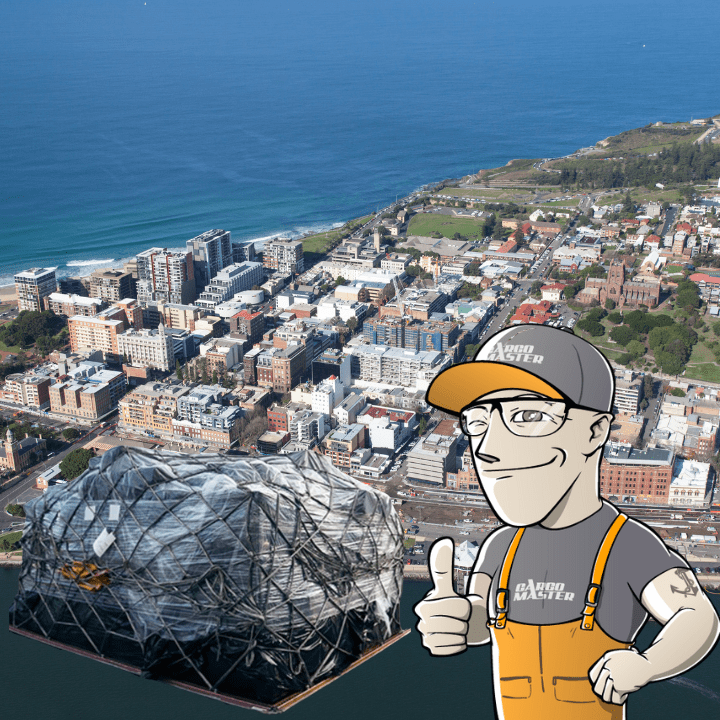Newcastle | Air Cargo
Newcastle Air Cargo | Fast & Reliable Domestic Air Freight Services
Newcastle Airport – IATA Code – NTL
Air Freight Newcastle
 Newcastle Airport is a key player in Australia’s air freight network, connecting businesses and individuals with destinations across the country and beyond. Strategically located about 15 kilometers from Newcastle’s central business district, this airport handles significant cargo volumes, making it an essential hub for air freight in New South Wales. The major airlines operating through Newcastle provide seamless freight solutions, ensuring efficient transit for time-sensitive cargo.
Newcastle Airport is a key player in Australia’s air freight network, connecting businesses and individuals with destinations across the country and beyond. Strategically located about 15 kilometers from Newcastle’s central business district, this airport handles significant cargo volumes, making it an essential hub for air freight in New South Wales. The major airlines operating through Newcastle provide seamless freight solutions, ensuring efficient transit for time-sensitive cargo.
At CargoMaster, we leverage Newcastle Airport’s capacity to offer fast, reliable air freight services, catering to both domestic and international needs. Whether you’re a business in need of frequent shipments or an individual with an urgent delivery, CargoMaster has the expertise and infrastructure to ensure your goods reach their destination on time.
Efficient Air Freight Solutions
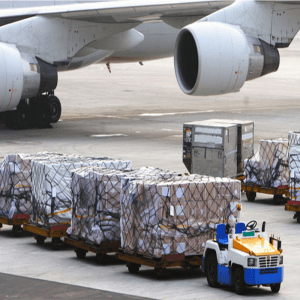 If you’re looking for the fastest way to move cargo across Australia, CargoMaster’s air freight services are designed with speed and reliability in mind. With over 35 years of experience, we specialize in time-sensitive shipments, offering solutions like overnight and same-day air freight. Whether you’re dealing with bulky, valuable, or awkward shipments, CargoMaster can handle it with precision, ensuring your goods are treated with care throughout their journey.
If you’re looking for the fastest way to move cargo across Australia, CargoMaster’s air freight services are designed with speed and reliability in mind. With over 35 years of experience, we specialize in time-sensitive shipments, offering solutions like overnight and same-day air freight. Whether you’re dealing with bulky, valuable, or awkward shipments, CargoMaster can handle it with precision, ensuring your goods are treated with care throughout their journey.
Our team understands that air freight requires a level of expertise and Know-How, which is why we offer tailored services that include heavy-lift air cargo and after-hours transportation. From Newcastle to anywhere in Australia, CargoMaster ensures your cargo arrives safely, on time, and in perfect condition.
Domestic Air Freight Newcastle
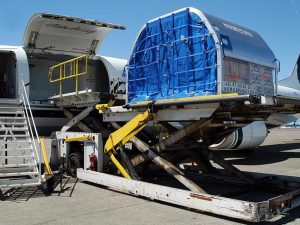 CargoMaster’s domestic air freight services in Newcastle provide businesses with a fast and secure method of shipping. In many cases, air freight is a more efficient alternative to traditional ground or sea transport, especially for fragile or time-sensitive goods. Our services are ideal for businesses seeking to move goods across Australia quickly, whether it’s an urgent shipment or a scheduled delivery.
CargoMaster’s domestic air freight services in Newcastle provide businesses with a fast and secure method of shipping. In many cases, air freight is a more efficient alternative to traditional ground or sea transport, especially for fragile or time-sensitive goods. Our services are ideal for businesses seeking to move goods across Australia quickly, whether it’s an urgent shipment or a scheduled delivery.
With a range of pickup options across Newcastle, CargoMaster provides door-to-door solutions tailored to your needs. Our fleet includes everything from vans to larger trucks with tail lift services, ensuring your goods are collected and transported with ease, regardless of size or shape. Air freight in Newcastle is fast, secure, and reliable with CargoMaster.
Advanced Air Cargo Tracking and Technology
![]() Technology plays a vital role in air freight logistics, and at CargoMaster, we use advanced tracking systems to monitor your cargo from the moment it’s picked up until it reaches its destination. This transparency ensures that you’re always informed about the location of your shipment, providing peace of mind, especially for high-value or sensitive goods.
Technology plays a vital role in air freight logistics, and at CargoMaster, we use advanced tracking systems to monitor your cargo from the moment it’s picked up until it reaches its destination. This transparency ensures that you’re always informed about the location of your shipment, providing peace of mind, especially for high-value or sensitive goods.
Newcastle’s air cargo operations benefit from CargoMaster’s innovative logistics solutions. Our tracking and reporting tools make it easy for clients to follow their cargo in real time, helping you stay informed and ensuring everything runs smoothly from pickup to delivery.
Cost-Effective International Air Freight
 For international shipments, CargoMaster offers Newcastle businesses and individuals affordable, efficient air freight options. Our international air cargo services include consolidated freight, which allows you to save time and money by combining your shipment with others heading to the same destination. Whether you’re shipping to neighboring countries or distant locations, we provide the best value for your air cargo needs.
For international shipments, CargoMaster offers Newcastle businesses and individuals affordable, efficient air freight options. Our international air cargo services include consolidated freight, which allows you to save time and money by combining your shipment with others heading to the same destination. Whether you’re shipping to neighboring countries or distant locations, we provide the best value for your air cargo needs.
CargoMaster’s international air freight services are designed to balance speed and cost. With competitive air freight rates and flexible transportation options, we ensure that your goods are moved quickly and efficiently without compromising on quality.
Why Choose CargoMaster?
When it comes to reliable and efficient air freight in Newcastle, CargoMaster stands out as a leading provider. Our experience, combined with our commitment to customer satisfaction, ensures that your cargo is always in good hands. We offer specialized services for oversized, awkward, or time-sensitive shipments, delivering exceptional results for even the most complex freight challenges.
Choose CargoMaster Newcastle for all your air freight needs and experience the difference that comes from working with seasoned professionals who are dedicated to getting your cargo where it needs to be—on time, every time.
Frequently Asked Questions
How do I book air freight
Booking air freight with CargoMaster is easy. Simply call us 24/7 on 1300 767 136 to make your urgent air freight bookings.
What documentation is needed when consigning air freight?
For domestic air freight, you’ll need to declare whether the cargo is NON HAZ or HAZ on the consignment note. A packing list is always useful. For international air freight, an airway bill is required.
How is air freight cost calculated?
Air freight costs are based on the chargeable weight, which is either the volumetric weight or the actual weight, whichever is greater.
What is the difference between air cargo and air freight?
There is no difference between air cargo and air freight. They are simply different terms used to describe the same method of transport.
What are the air freight rates per ton?
Air freight is usually charged per kilogram. To get the rate per ton, multiply the kilogram rate by 1,000. For special rates on large consignments, call CargoMaster for a spot deal.
For all your Newcastle air freight needs, contact CargoMaster today at 1300 767 136 and let us take care of your logistics while you focus on what matters most.
Air Freight Australia Wide
Sydney, Melbourne, Brisbane, Perth, Adelaide, Canberra, Hobart, Launceston, Newcastle, Gold Coast, Mackay, Townsville, Cairns, Darwin

Air Freight Newcastle
Call: 1300 767 136 Nationwide
Air Cargo World-Wide, Door to Door
Air Cargo Charter Services Available Australia Wide
Addition Information
(Click the +/- plus/minus symbols to expand/collapse)
AUSTRALIAN AIRPORT CODES
| Adelaide | Australia | ADL |
| Albury | Australia | ABX |
| Alice Springs | Australia | ASP |
| Avalon | Australia | AVV |
| Ayers Rock | Australia | AYQ |
| Ballina | Australia | BNK |
| Ballina Airport | Australia | BNK |
| Brisbane | Australia | BNE |
| Broome | Australia | BME |
| Broome | Australia | BME |
| Cairns | Australia | CNS |
| Canberra | Australia | CBR |
| Coffs Harbour | Australia | CFS |
| Darwin | Australia | DRW |
| Dubbo Airport | Australia | DBO |
| Gladstone | Australia | GLT |
| Gold Coast | Australia | OOL |
| Hamilton Island | Australia | HTI |
| Hobart | Australia | HBA |
| Kalgoorlie | Australia | KGI |
| Karratha | Australia | KTA |
| Kununurra | Australia | KNX |
| Launceston | Australia | LST |
| Mackay | Australia | MKY |
| Maroochydore | Australia | MCY |
| Melbourne | Australia | MEL |
| Mildura | Australia | MQL |
| Mount Isa Airport | Australia | ISA |
| Newcastle | Australia | NTL |
| Newman | Australia | ZNE |
| Perth | Australia | PER |
| Port Hedland | Australia | PHE |
| Port Macquarie | Australia | PQQ |
| Proserpine | Australia | PPP |
| Rockhampton | Australia | ROK |
| Sunshine Coast | Australia | MCY |
| Sydney | Australia | SYD |
| Townsville | Australia | TSV |
HIDDEN DANGEROUS AIR CARGO
Please Note: The below list does not describe all types of hazardous air cargo (it is not exhaustive and all encompassing). General items listed below may be found in baggage and possibly have hazards that are not immediately apparent. There are strict laws in relation to lodging of hazardous air cargo and compliance with hazardous air cargo regulations.
Typical examples of hazardous air cargo
Engines (contain fuel and that are not cleaned, purged and sealed)
Mining equipment
Magnets
Pressurised containers
Passenger baggage (containing flammable gas or liquid lighter refuel. camping stove cylinders
Photographic Supplies
Expeditionary equipment
Vaccines
Solvents, adhesives
Pesticides
Dental apparatus
Machinery parts
Frozen foods (packed in solid dry ice)
Dry Ice
Tool Boxes (compressed gases, aerosols)
Electrical equipment
Diving equipment
Pharmaceuticals
Switches in electrical equipment
Toys (made of cellulose)
Refrigerators (may contain gases or chemicals)
Swimming pool chemicals
Pressurised containers
Engines (contain fuel and that are not cleaned, purged and sealed)
Mining equipment
Diagnostic specimens
Thermometers (containing mercury)
Frozen Embryos
Ammunition
Swimming pool chemicals
Aerosols
Compressed non-flammable gas
Batteries
Breathing Apparatus
Frozen foods (packed in solid dry ice)
Motor Vehicle parts
Chemicals
HAZARD LABELS DANGEROUS GOODS (DG)
Hazard Labels for
Dangerous Goods (DG)
The international community has established a classification system for easy identification of dangerous goods. These goods fall into nine primary classes, and some classes are further divided to address specific risks. Each class/division has a corresponding label that accurately represents the nature of the hazard. These labels must be attached to the package during transport and remain intact throughout the journey. Take a look at the illustrated examples below to understand how these labels effectively communicate the potential dangers.
Under regulations, labels must be clearly visible on the outside of the package and must stay on the package while in transit.
You can often find labels printed on most inner packages such as:
- aerosol cans
- bottles of bleach
- containers of thinners
- tins of paint
- many other products which are available at supermarkets and hardware stores.
Below are the 9 hazard labels for the 9 classes of dangerous goods.
Class 1 Explosives

This includes items such as:
- explosive substances
- pyrotechnic devices
- ammunition
- fireworks
- detonators.
Class 2 Gases

These can be transported as:
- compressed
- liquefied
- refrigerated liquefied
- gas in solution.
This includes aerosols. Class 2 has 3 divisions:
- Division 2.1 - flammable gases such as:
- butane
- propane
- Division 2.2 - non-flammable, non-toxic gases such as:
- oxygen
- liquid nitrogen
- compressed air
- Division 2.3 - toxic gases such as:
- chlorine
- hydrogen sulphide.
Class 3 Flammable liquids

This includes liquids with a boiling point of 35⁰ C or less, or a flash point of 60⁰ C or less such as:
- petrol
- alcohol
- perfumes
- essential oils
- hand sanitiser
- paints.
Class 4 Flammable solids

These are substances that can spontaneously combust and substances, that when they come into contact with water or emit flammable gases. Class 4 has 3 divisions:
- Division 4.1 - flammable solids such as:
- hexamine solid fuel tablets for camping stoves
- self-reactive substances
- desensitised explosives
- Division 4.2 - substances that can spontaneously combust under normal air transport conditions include:
- camphor
- sulphur
- matches
- Division 4.3 - substances that emit flammable gases when they come into contact with water include:
- sodium
- zinc particles
- activated carbon.
Class 5 Oxidising substances and organic peroxides

These substances are not necessarily combustible on their own but can react dangerously with other substances. Class 5 has 2 divisions:
- Division 5.1 - oxidising substances that may not be necessarily combustible, but they may readily yield oxygen and cause other materials to combust, such as:
- hydrogen peroxide
- ammonium nitrate
- potassium chlorate
- sodium nitrate
- Division 5.2 - organic peroxides are thermally unstable and can emit heat and give off harmful or flammable vapours. They can also be liable to explosive decomposition and react dangerously with other substances. Examples are:
- acetyl acetone peroxide
- benzoyl peroxide
- peracetic acid.
Class 6 Toxic and infectious substances

These substances can cause sickness, injury or death if consumed. Class 6 has 2 divisions:
- Division 6.1 - toxic substances that can cause death, injury or to harm human health if swallowed, inhaled or by skin contact, such as:
- chloroform
- arsenics
- cyanides
- cytotoxic waste
- barium compounds
- pesticides
- Division 6.2 - infectious substances that contain or are expected to contain pathogens that can cause disease in humans or animals, including:
- medical or clinical waste
- patient specimens
- genetically modified organisms
- infectious substances
- infected animals.
Class 7 Radioactive materials

These are substances that emit invisible ionising radiation that can be harmful to humans and animals. It can cause objects such as aircraft and equipment to become contaminated if not packaged and handled correctly, such as:
- uranium
- radioactive ores
- isotypes
- radium
- cesium
- x-ray equipment
- medical equipment or parts.
Class 8 Corrosives

These substances can cause irreversible damage if they come into contact with skin and could destroy other freight, or materially damage containers or aircraft. This includes:
- acids
- corrosive cleaners
- battery fluid
- formaldehyde
- hydrofluoric acid.
Class 9 Miscellaneous
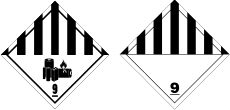
These are substances and articles which, during air transport, present a danger not covered by other classes. There are 2 types of handling labels – 1 for lithium battery shipments, and another for all other miscellaneous dangerous goods. This class includes:
- lithium batteries
- battery powered vehicles
- battery powered equipment
- first aid kids
- environmentally hazardous substances
- dry ice
- magnetised materials
- asbestos.
Handling labels
In addition to hazard labels, trained staff must attach handling labels where needed. Staff must use these 4 handling labels with the appropriate hazard labels:
Cargo aircraft only

This label is used to show that the load cannot be carried on a passenger aircraft.
Cyrogenics

This label is used on liquefied gases, such as the ones in Class 2.
This way up

This label ensures a load is placed the correct way up and can be used for non-dangerous goods.
Magnetised material

This label ensures that the load is kept away from the aircraft compass detector unit while being loaded and unloaded.
AIR FREIGHT AUSTRALIA DOMESTIC AIRLINES
| Airline | Airline Code | Customer Service | Sales Office | Website | |
 | TL | 1800 627 474 | 1800 627 474 | http://www.airnorth.com.au/ | |
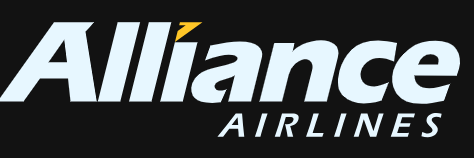 | 1300 780 970 | 1300 780 970 | http://www.allianceairlines.com.au/ | ||
 | JQ | 13 15 38 | +61 3 9645 5999 | http://www.jetstar.com | |
 | QF | 13 13 13 | http://www.qantas.com.au | ||
 | ZL | 13 17 13 | http://www.regionalexpress.com.au | ||
 | VA | 13 67 89 | http://www.virginaustralia.com | ||
| Provider | Website | ||||
| Swissport Australia | www.swissport.com | ||||
| Air Menzies International (AMI) | https://airmenzies.com/ | ||||
| Patrick Air Services | http://w.auww.patrick.com | ||||
| Qantas Airways (passenger & ramp handling) | http://www.qantas.com.au | ||||
| Toll Dnata | http://www.tolldnata.com | ||||
AIR FREIGHT FREIGHTER SPECIFICATIONS
| Make/Model | Max Payload Tonnes | Max Loadable Volume CBM3 | Cargo Hold Dims LxWxH cm | Cargo Door Size WxH cm |
| Cessna 406 Titan | 1.2 | 6.5 | 320 x 120 x 117 | 124 x 116 |
| Fairchild Metroliner II | 1.4 | 12 | 835 x 115 x 120 | 130 x 115 |
| Fairchild Metroliner III | 2.1 | 12 | 775 x 158 x 145 | 130 x 115 |
| Fairchild Metroliner 23 | 2.3 | 18 | 775 x 158 x 145 | 127 x 115 |
| Falcon 20 / 200 | 2.5 | 11 | 704 x 156 x 142 | 190 x 140 |
| Shorts 360 | 3.5 | 40 | 815 x 190 x 190 | 142 x 168 |
| Saab 340 | 3.8 | 40 | 1300 x 170 x 170 | 135 x 130 |
| Aerospatiale ATR42 | 4.6 | 40 | 1080 x 225 x 143 | 125 x 153 |
| Fokker 27 | 6.3 | 58 | 1336 x 210 x 190 | 228 x 175 |
| Antonov AN-26 | 6.5 | 45 | 1110 x 220 x 160 | 230 x 171 |
| Antonov AN-74 | 6.5 | 45 | 1000 x 215 x 220 | 226 x 220 |
| British Aerospace ATP | 8.2 | 78 | 1500 x 195 x 180 | 250 x 169 |
| Lockheed L-188 Electra | 15 | 135 | 2000 x 280 x 220 | 355 x 203 |
| Boeing 737-300F | 16 | 115 | 2100 x 310 x 220 | 340 x 215 |
| Antonov AN-12 | 18 | 95 | 1380 x 300 x 250 | 300 x 250 |
| Lockheed L-100 Hercules | 21 | 140 | 1707 x 302 x 274 | 302 x 274 |
| Boeing 727-200F | 23.5 | 144 | 2712 x 351 x 218 | 340 x 218 |
| Boeing 757F | 39 | 187 | 3327 x 353 x 218 | 340 x 218 |
| Airbus A300 B4F | 40 | 280 | 3900 x 477 x 223 | 358 x 256 |
| Douglas DC8-62 | 40 | 200 | 3400 x 317 x 203 | 355 x 215 |
| Douglas DC8-54/55 | 41 | 180 | 3100 x 317 x 203 | 355 x 215 |
| Ilyushin IL-76 | 45 | 180 | 1850 x 345 x 325 | 344 x 340 |
| Antonov AN-22 | 50 | 650 | 2640 x 430 x 430 | 430 x 430 |
| Lockheed L10-11 Tristar | 55 | 420 | 3300 x 360 x 274 | 431 x 284 |
| Boeing 767-300F | 55 | 400 | 3000 x 400 x 250 | 340 x 254 |
| Douglas DC10-30 | 65 | 400 | 3725 x 448 x 245 | 350 x 245 |
| McDonnell Douglas MD11 | 85 | 500 | 4800 x 350 x 245 | 355 x 245 |
| Boeing 747-100F | 90 | 675 | 4800 x 488 x 300 | 340 x 300 |
| Boeing 747-200F | 100 | 675 | 4900 x 488 x 300 | 340 x 300 |
| Boeing 777F | 100 | 625 | 4400 x 488 x 300 | 372 x 305 |
| Boeing 747-300/400F | 110 | 675 | 5000 x 488 x 300 | 340 x 300 |
| Antonov AN-124 | 120 | 800 | 3650 x 640 x 440 | 640 x 440 |
| Antonov AN-225 | 250 | 1100 | 4300 x 640 x 440 | 640 x 440 |
UNIT LOAD DEVICES (ULD)
Types of Unit Load Devices Used in Australia
AKE Container
- Type: AKE CONTAINERATA Code: LD3
- Internal Volume: 152 cu. ft. 4.3 mc
- Weight Limit: 1,588 kg
- Loadable Aircraft Type: 747, 747F, 777, Airbus
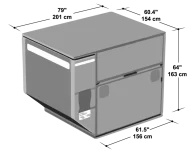 AAU Container
AAU Container
- Type: AAU CONTAINER
- ATA Code: LD29
- Internal Volume: 505 cu. ft. 14.3 mc
- Weight Limit: 4,626 kg
- Loadable Aircraft Type: 747, 747F
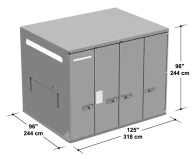 ALF Container
ALF Container
- Type: ALF CONTAINER
- ATA Code: LD6
- Internal Volume: 310 cu. ft. 8.78 mc
- Weight Limit: 3,175 kg
- Loadable Aircraft Type: 747, 747F,777, Airbus
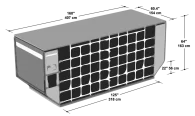 AMA Container
AMA Container
- Type: AMA CONTAINER
- ATA Code: M1
- Internal Volume: 621 cu. ft. 17.58 mc
- Weight Limit: 6,804 kg
- Loadable Aircraft Type: 747F
 AMF Container
AMF Container
- Type: AMF CONTAINER
- Internal Volume: 516 cu. ft. 14.6 mc
- Weight Limit: 5,035 kg
- Loadable Aircraft Type: 747,747F, 777, Airbus
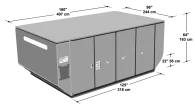
P1P_PAG Pallet
- Type: P1P, PAG PALLET
- Size:
- Base: 88″x 125″
- Height: 64″, x 96″,118″
- Weight Limit: 4,626kg
(LD),6,033kg (MD) - Loadable Aircraft Type: 747,747F, 777, Airbus
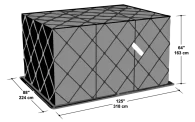 PEB Container
PEB Container
- Type: PEB CONTAINER
- Size:
- Base: 53″ x 88″
- Height: 84″
- Weight Limit: 1,800kg
(B-HIH -1,300 KG) - Loadable Aircraft Type: 747F
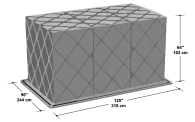 PLA Pallet
PLA Pallet
- Type: PLA PALLET
- Size:
- Base: 60.4″x 125″
- Height: 64″
- Weight Limit: 3,175kg
Loadable Aircraft Type: 747, 747F, 777, Airbus
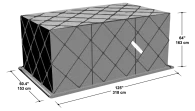 PMC_PQP_P6P Pallet
PMC_PQP_P6P Pallet
- Type: PMC, PQP, P6P PALLET
- Size: Base: 96″ x 125″
- Weight Limit: 5,035 kg (LD), 6,804 kg (MD)
- Loadable Aircraft Type: 747, 747F, 777, Airbus
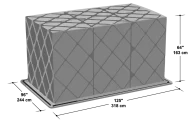 RKN Container
RKN Container
- Type: RKN CONTAINER
- ATA Code: LD3
- Internal Volume: 125.41 cu. ft. 3.55 mc
- Weight Limit: Weight: 1,588 kg
- Loadable Aircraft Type: 747, 747F, 777, Airbus
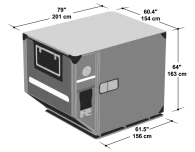 VZA_VRA
VZA_VRA
- Size: Fitted on PGA 20 ft. Pallet
- Max Width for Lower Car: 81″/ 205 cm
- Max Centre Height for Lower Car: 59″/ 150 cm
- Max Wheel Base: 312 cm
- Weight Limit: 2,500 kg(Upper Car)
9,300 kg c(Max Gross Weight of Pallet) - Loadable Aircraft Type: 747F Upper Deck

Unit Load Devices (ULD)
As of January 2023, over one million Unit Load Devices (ULDs) are in use globally. A ULD can take the form of an aircraft pallet, a pallet/net combination, or an aircraft container. These devices are considered removable parts of an aircraft and are regulated by civil aviation authorities. To be deemed airworthy, a ULD must be structurally sound, capable of restraining cargo, and designed to protect both the aircraft’s systems and structure during flight.
ULDs undergo regular testing to ensure they meet strict aviation authority standards. This rigorous process ensures that they continue to comply with design and safety regulations.
What sets ULDs apart from other aircraft components is that they are the only parts that can be removed and returned to the aircraft after handling by unregulated operators. Despite this, ULDs play a crucial role in flight safety by securing cargo and maintaining aircraft integrity during transit.
INCOTERMS
INCOTERMS are standard trade terms most commonly used in international freight contracts for sale of goods. It is essential that you are aware of your terms of trade prior to shipment.
EXW – EX WORKS (… named place of delivery)
The Seller’s only responsibility is to make the goods available at the Seller’s premises. The Buyer bears full costs and risks of moving the goods from there to destination.
FCA – FREE CARRIER (… named place of delivery)
The Seller delivers the goods, cleared for export, to the carrier selected by the Buyer. The Seller loads the goods if the carrier pickup is at the Seller’s premises. From that point, the Buyer bears the costs and risks of moving the goods to destination.
CPT – CARRIAGE PAID TO (… named place of destination)
The Seller pays for moving the goods to destination. From the time the goods are transferred to the first carrier, the Buyer bears the risks of loss or damage.
CIP– CARRIAGE AND INSURANCE PAID TO (… named place of destination)
The Seller pays for moving the goods to destination. From the time the goods are transferred to the first carrier, the Buyer bears the risks of loss or damage. The Seller, however, purchases the cargo insurance.
DAT – DELIVERED AT TERMINAL (… named terminal at port or place of destination)
The Seller delivers when the goods, once unloaded from the arriving means of transport, are placed at the Buyer’s disposal at a named terminal at the named port or place of destination. “Terminal” includes any place, whether covered or not, such as a quay, warehouse, container yard or road, rail or air cargo terminal. The Seller bears all risks involved in bringing the goods to and unloading them at the terminal at the named port or place of destination.
DAP – DELIVERED AT PLACE (… named place of destination)
The Seller delivers when the goods are placed at the Buyer’s disposal on the arriving means of transport ready for unloading at the names place of destination. The Seller bears all risks involved in bringing the goods to the named place.
DDP – DELIVERED DUTY PAID (… named place)
The Seller delivers the goods -cleared for import – to the Buyer at destination. The Seller bears all costs and risks of moving the goods to destination, including the payment of Customs duties and taxes.
MARITIME TERMS
FAS – FREE ALONGSIDE SHIP (… named port of shipment)
The Seller delivers the goods to the origin port. From that point, the Buyer bears all costs and risks of loss or damage.
FOB– FREE ON BOARD (… named port of shipment)
The Seller delivers the goods on board the ship and clears the goods for export. From that point, the Buyer bears all costs and risks of loss or damage.
CFR– COST AND FREIGHT (… named port of destination)
The Seller clears the goods for export and pays the costs of moving the goods to destination. The Buyer bears all risks of loss or damage.
CIF – COST INSURANCE AND FREIGHT (… named port of destination)
The Seller clears the goods for export and pays the costs of moving the goods to the port of destination. The Buyer bears all risks of loss or damage. The Seller, however, purchases the cargo insurance.
Thank-you for contacting us, we appreciate the opportunity.
If your shipment relates to air freight or less than a container load of sea freight.
Please include the weight and dimensions of each piece in your request.
We look forward to working with you, please feel free to call at any time.
Call: 1300 767 136

